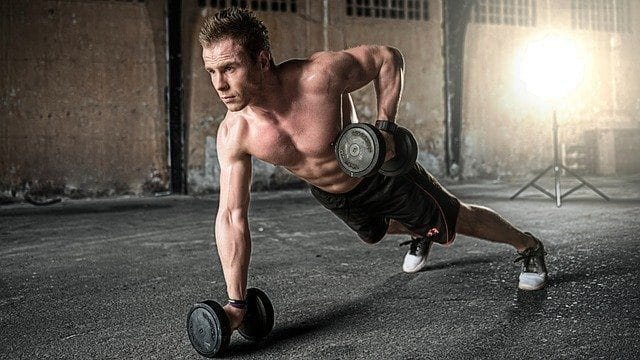“What do Conor McGregor, Rickson Gracie, Movement, and Kung Fu have in common? The use of movement drills to increase the mobility, reflexes, balance, strength, and speed in practitioners. This skill was nearly lost, but a few are bringing it back. Most recently with Conor McGregor and Ido Portal.
While Ido is concerned with movement for the sake of movement and not necessarily for fighting, Conor credits part of his mystique to his practice with Ido. However, Conor was not the first to train this way. Rickson Gracie was training to become a better mover before MMA was really born. Taking on challengers from different styles, he is widely considered to be one of the best fighters to come out of the Gracie family.
Long before both of these fighters, masters in China used movement drills in various forms to improve fighter skills. These were largely exaggerated in old kung fu movies and were soon seen as just entertainment and not practical for "real fighting.
"Truth is, those watching did not know—what they didn’t know, i.e., the teachings of a kung fu master. It appears these movement drills were actually an ancient training system designed to maximize agility, strength, resilience, endurance, flexibility, and available power in the combat arts, while swiftly achieving peak condition and easing recovery.” –Lee Yakota, 8 Step Mantis Kung Fu Master and instructor at Kung Fu USA. See this video and others at Mantis Mechanics.
The Training Debate
The debate on Combat Arts strength and conditioning achieving peak performance is fueled by how to optimize training in order to receive the greatest benefits the quickest from the least amount of time spent has been raging on for years. There is one camp that claims longer, tougher workouts while training less frequently is the way to go.
Another camp says training 5 or 6 days a week but using less intensity will carve out that primo body and killer skills, while some say medium intensity training every day is the best answer. Then they’re the ones who say ‘train every day, top intensity, or forget about it!’
The correct answer to that question ultimately relies upon you as a unique individual, and your specific goals.
Within that, however, there are many variables to factor in that will help clarify it for you. Dr. Jason Gillis says in MMA Training Bible:
“For example, muscular power is optimized after you have first developed a solid base of strength, and anaerobic endurance is optimized after a solid base of aerobic endurance has been developed.”
That makes it clear that once you have muscle, it’s relatively easy to add more, and once aerobic endurance is optimized, solid gains can be made on anaerobic endurance. Check out the possibilities, try them on for size, and see exactly what fits, what makes your body jump with excitement, raring to roll, and eager to get up in the morning. After all unleashing the cardio beast using advanced cardio methods is what we strive to achieve.
How Many Training Sessions per Day
More than one training session per day? The beginning and intermediate martial artist, or non-professional fighter may stop at one training session per day. The seasoned fighter, however, will benefit from and quickly see massive gains in strength, agility, endurance, and explosive power through adding another training session every day.
Two shorter training sessions per day rather than one longer session gives optimal results. Early morning sessions are great for improving specific skill sets. The brain is refreshed and ready to absorb new information, while the body picks up techniques and retains them with ease.
Save endurance training, repetitive strength training exercises such as rolling over giant tires or practicing with exercise bands until the later session, allowing as much recovery time between sessions as possible.
The Research is Finally In
There are some honest answers and clear direction on how to maximize muscle, strength, endurance, speed, and skills without destroying yourself in the process, overtraining, or becoming a hermit who sleeps in the gym. This is good news for the martial artist seeking to optimize skills and techniques, while minimizing chance of injury, and still having time leftover for a great life.
Researchers have investigated a variety of martial arts styles and other sports that have similar physiological requirements to martial arts and MMA including aerobic, anaerobic, metabolic, and muscle-specific training. These particular studies focused on Muay Thai, Judo, wrestling, boxing, and grappling.
The research clearly showed that utilizing fight and sport-specific training and conditioning are premium techniques helping fighters achieve peak fight condition. For instance, martial artists will improve most quickly through practicing their styles of fighting, grappling, and striking rather than weight lifting, for instance, in order to improve consistently. Combine that with interval training to pump up aerobic and anaerobic levels, a powerful strength and conditioning program to toughen and strengthen neck, joints, tendons, hands, and keep muscle strength balanced.

Adding alternative training techniques, such as giant tire rolling, fight-specific punching and kicking with strong resistance bands, battle ropes, box jumping, sledgehammer blow, jogging with a backpack full of rocks, or even incorporate iron body techniques so when your opponent kicks your leg or arm it minimizes overall damage to your body, while leaving your opponent with extreme damage.
The Personal Approach
Always within any official debate there remains the reality of the individual. How each person’s body, mind, and emotions respond to a certain style of training, nutrition, sleep requirements, type of training and approach, along with lifestyle restrictions, will impact any general recommendations on training techniques.
Other factors include alcohol consumption, high junk food consumption, extremely high stress levels, and chronic lack of sleep issues, along with how well your body handles extreme training intensity and frequency, recovery speed, and types of specific skills, strength, agility, etc., that the martial artist is training to improve.
For instance, the fighter with a slow recovery time, less than perfect genetics, and heavy family or school obligations may require a shorter duration, medium interval and volume, but multi-session training schedule.
The martial artist who’s training for UFC events, however, with its weight class demands, tight scheduling, and ‘do or die’ warrior fighting approach may train 6 days a week, or even every day, and have less leeway for trying different training techniques than the martial artist who is a ‘lifer,’ plans to train for the rest of their life, but is not necessarily devoted to the professional fighter lifestyle.
The martial artist who has some joint weakness, rotator cuff, back, or ankle issues that have been compromised through previous injury will likewise want to pick and choose amongst proven successful techniques that optimize their strengths while minimizing chances of re-injury.
Know Your Body—Fast Twitch or Slow Twitch Dominant
This one is easy: what feels better, what feels more difficult, what do you like doing, or what do you tend to avoid. That will tell clearly if you have a predominance of fast twitch or slow twitch muscle fibers, or a fairly even distribution.
No matter which you have, however, it is simple to strengthen and increase the type you want using different training methods. Fighters in general need a high number of fast twitch muscle fibers for speed and explosive power. However, slow twitch muscles give stamina and endurance, making sure you’re the last one standing.
Difference between Fast Twitch and Slow Twitch

Fast twitch muscle fibers are known as type IIb, have a larger diameter, quickly create intensive action/reaction or response with high force, and run out of gas fast. Slow twitch muscles are known as type I and have a smaller diameter.
They produce a lower force and slower action/reaction, but keep on going for a long time. The last type of muscle fibers lands right in between these two and is known as type IIa. They create more force than the slow twitch, though not as much as the fast, and have medium endurance.
The ratio of fast twitch to slow twitch muscle fibers is fixed at birth, with most people having an even proportion of both, along with medium muscle fibers. Fast twitch muscles fibers are very dense, like white meat chicken, while slow twitch muscle fibers are similar to dark meat. So basically, muscle fiber types in the body will span the full range from fast to medium to slow, each fulfilling a certain need.
A higher percentage or harder trained fast twitch muscle fibers are essential for the martial arts warrior and events fighter, for instance, while those with a higher percentage or harder trained slow twitch muscle fibers excel at long distance running, cycling, etc., or any sport requiring long term effort and endurance.
Train for Speed
Training for speed is ultimate for the martial artist. Power without speed, endurance without speed, agility without speed; they all add up to zero without speed. Bruce Lee began his martial arts by training in wing chun, which he felt gave his hands a superior speed advantage because of its emphasis on smallest required movement and straight line theory.
Every top martial artist has that in common—great speed. Add speed to explosive power and you’ve got a win. Now put this idea together with various training combinations to push those fast twitch fibers harder, faster, and longer, always while ensuring excellent form, of course. For example, add explosive training when weight lifting to target fast twitch fibers.
When running or jogging for more aerobic endurance, add several short-burst, intensive sprints. Punches? Medicine ball Russian Twists? Add one minute or more top intensity and top speed punching sequences, or several top speed twisting sequences.
A Variety of Advanced Strength Training Techniques
Allowing for that personal reality within the professional and lifestyle martial arts training approach means that a variety of training techniques are necessary and will be presented in this article, Advanced Conditioning Techniques, Part II, and Advanced Conditioning Techniques, Part III.
These techniques can be used serially, rotated in and out weekly or monthly, producing optimal results while keeping training fresh. Martial artists can find one they like and stick with it, or pick them up and trade them out, depending on how fast their bodies respond, if they get a quick positive return, if their physical and emotional aspects feel better and psyched, hyper and nervous, or dragged out.
Training to Failure
This is a traditional approach to training that was based on the concept that pushing muscles until they ‘fail’ or cannot continue will result in pushing physical abilities to a higher level. Research on has debunked this idea as invalid. We now know that Combat Arts Strength Training is the foundation of a fighters success.
Your body may feel really spent, sore, and used up, giving athletes the misconception that they just did the best, most total workout ever—but research shows it was probably less effective rather than more. Training is performed to improve a skill, amp up an ability, max out strength or power. Typically, the first round or session will have optimal form and speed, giving back a good return.
Research has shown, however, that eventually, before the training fighter gets to total failure form inevitably gets sloppy, teaching the body incorrect stances, movements, and energy usage. At that point, the fast twitch muscles aren’t targeted any more, and the body switches over to using slow twitch muscles, defeating the purpose of training for speed, power, and explosive power.
Overall, training to failure early in sessions limits the amount of reps and volume possible to achieve, makes overtraining and possibility of injury more likely, and is simply not necessary, with no direct evidence proving the efficiency of this method over the long term. Training to failure as a workout approach does not give the best results.
Training Frequency for Optimized Muscle Response
Generally, training a minimum of three times a week, and a max of six times a week, rolls in as the overall consensus for optimizing muscle growth. Two or less times a week does not push physical fitness far enough, fast enough (unless you’re a newbie), whereas training every day of the week for many people can easily lead to burnout, overtraining, injury and fatigue. There are proponents in every camp, whether daily, frequently, or three or less workouts a week, who will prove that this method works for them.
But will it work for you? Important questions to ask include; do they have a similar body type to mine, do I want the kind of lifestyle required by their workouts, what are my short term and long-term goals?
That is where personal physical and lifestyle requirements come in: logistics like how many days a week do you reliably have available for training; how many hours per day; how much time do you have—and need—for recovery; current level of fitness; purpose for training—UFC or MMA contender, getting your next belt asap, improve performance in events, or just get into the greatest shape of your life; and do you get bored easily and like to shake things up or prefer a steady, predictable approach to training that pays off over time.

No Right Answer—Only What’s Right for You
On thing is clear: Combat Arts Strength Training is the foundation of a fighters success. The point here is that there is no single approach, no one training guru who’s got all the answers, no ideal one-size-fits-all method of training will guarantee success.
The good news is—there are a lot of great techniques and training methods out there that include everything from tried-n-true, new and exciting, ancient and proven, steady and predictable, to ‘fun and squirrely,’ yet they work. Looking for some new yet old, tried and proven, but really different training techniques?
Training Six to Seven Days per Week

Anastasia Zinchenko is a body builder, international level powerlifter, and scientist with a PhD in biochemistry. If you are a seasoned fighter, Zinchenko advises to train every day, or at least six days a week for optimal muscle growth and conditioning.
She has good reason for making these recommendations since research has proven that after training sessions muscle growth continues for 16-24 hours in advanced trainees, but up to 72 hours for beginners. One experiment with professional Russian weightlifters which utilized exacting parameters had two sets of competitive powerlifters who all did exactly the same routine, same weights, same duration, and intensity.
The only difference between the two groups was whether they trained the traditional three times per week or trained six times per week. The group training six times per week killed it, with measurable increases in lifting power and gains in muscle mass.
This means that for the trained martial artist with good recovery abilities, workout sessions performed six days a week, or daily for those with excellent recovery abilities and minimum 24 hours between sessions, can reasonably expect increasing returns from this training schedule.
Training 5 to 6 Times per Week
This number of training sessions per week is considered optimum by many researchers and training coaches. The chance of burnout or overtraining is minimized, while excellent results are guaranteed, particularly when two shorter daily sessions are incorporated. Studies have shown that doing overly long training sessions run the risk of ‘wasted’ effort, because past a certain point, the body no longer receives gains, but rather diminishes, from the effort. Diminishing gains is not what the warrior wants from training.
The idea of splitting training workouts to focus on different sets of muscle groups is also an established model that may need rethinking. Particularly when it’s been proven that sports-specific exercises and workouts are most effective, and obviously, these types of workouts in martial arts, at least, utilize all muscle groups.
Increasing Training Frequency
There has not been much research on the effects of training frequency, as opposed to intensity or volume. New evidence is suggesting that increasing frequency of training is one variable that can make all the difference, particularly for those athletes who have plateaued with their training.
According to research, increasing muscle size and strength can be achieved through increased frequency of training. Adding in extra training days, and/or two training sessions per day, may function to achieve the shift necessary to bust past plateaus. Dankel, S.J., et al, posited in their sports medicine research paper:
“We hypothesize that increasing the training frequency, as opposed to the training load or sets performed, may be a more appropriate strategy for trained individuals to progress a resistance exercise program aimed at increasing muscle size.”
Training 2 to 4 Times per Week
Ultimately it comes down to where you want to be compared to where you are now—and how fast you want to get there. If you are a beginner who has never really been in an intensive exercise program, then 1, 2 to 3 times per week will produce results.
One study that focused on untrained women who started lifting weights found they had significant improvements in muscle strength and endurance by using a low volume session with one set, or a high volume, periodized variable session using multiple sets two times per week. But notice these women were exercising for the first time.
Most martial artists by definition are beyond that unless they are returning. Many coaches recommend 3 to 4 times per week. This number is a good minimum, especially if doing two shorter sessions per day. However, only 1 or 2 exercise sessions per week is not recommended unless you are a true newbie, in recovery, or elderly and just getting started.
Want Stronger Muscles—Do This
Use longer rest periods between sets. Research has shown that incorporating longer rest periods between sets is one variable that will dramatically increase strength gained along with quickly increasing muscle size.
One study has shown that a high intensity workout utilizing high weight with low number of reps, for instance, 3 to 5 repetitions performed with a very high weight, using a long rest interval between sets of about 3-minutes will provide optimal stimulation for upper body muscle hypertrophy or size increase, and will quickly increase upper body strength. This 8-week study used men already accustomed to training.
The research testing tried all variations, including a lower resting time, lower weight with higher reps, etc. The study proved that long rest periods of 3-minutes combined with high weight intensity and low reps, resulted in the greatest muscle and strength increase.
Train Your Neck
Old-fashioned football coaches knew the value of intensive strengthening exercises specifically designed for the neck, to protect the larynx, throat, and spine, plus minimize chances of strain and other injuries.
The importance of having a strong neck cannot be overemphasized, the force of a blow hitting the head will be transferred and spread out if the neck muscles are powerful, thereby minimizing or eliminating injury. Also, strong neck muscles help support the head during and after impact, helping reduce chance of concussion.
There have been many studies proving that headlocks, most takedowns, many submissions, flying scissor takedowns, chokes, and neck cranks can affect the neck like whiplash from a car accident. Injury to the neck can be as slight as mild aching, to cervical sprains and strains, or worse. Martial arts practitioners benefit from neck exercises that strengthen, toughen, and add muscle to protect delicate neck structures. Also, simple wisdom says the neck is central to all that martial artists do, so protect it, strengthen it, if harmed get proper treatment so you can keep training for life.
But Don't Believe Us....
Professional boxing Coach Moritz Klatten stresses the importance of strengthening and training the neck when coaching his champions. Coach Klatten has trained three Olympic champions, four amateur world champions, and five professional world champions, and his list of athletes is impressive. Coach Klatten says training and strengthening the neck is commonly overlooked, but it dramatically reduces the chance of concussion.
In his book, The Klatten Power Boxing System, his regular, neck strengthening, and conditioning sections crossover very well with martial arts training requirements. Check out his video of very simple neck exercises by Ando Mierzwa, who is called Sensei Ando by his young karate students. Sensei Ando has his black belt in Tae Kwon Do and is an 8th degree black belt in Kung Fu San Soo.
When training the neck do exercises that utilize movements in every direction, whether having a partner work with you to carefully give resistance, using a neck strengthening resistance machine, or a simple exercise band attached to a fixed point or held by your own foot, etc., that allows you to do multiple resistance sets.
Training When Time is Short

Time constraints occasionally happen to us all, whether for shorter or longer periods of time. Maximizing workout gains is always high priority, but especially so when time crunching. When time is short, think specificity and functional, choosing training elements that really count.
That’s the time to go for compound exercises with functional specificity, which means choosing exercises that utilize many large muscle groups in a similar manner to the martial art or sport being trained for.
This means do not engage in isolated muscle training such as body building that only uses singular muscle systems in narrow movements. The beauty of functional training is that all movement improvements transfer directly over to the martial art style, events, UFC, etc., for which you are training.
Compound Exercises
Compound exercises target multiple muscle groups simultaneously and give your body that quick return even when time is short.
A few excellent choices include: burpees, jumping jacks, medicine ball Russian twist, Plyometric box jumps, clapping pushups (see Mantis Mechanics video listed below for proper form), rope climbing, giant tire rolling, squats, intensive swimming and/or diving, various types of pull ups, abdominal exercises, kettlebell swings, and the above using strap-on weights.
Also, when time is short, choose which muscle groups you consider most important to work on first. Train your thighs with 10 minutes or more of standing in low horse stance while retaining good form, for instance. If you want impressive biceps, do 5 sets or more of biceps curls every day, along with clapping pushups.
For full body advanced conditioning, try alternating 2 or 3 large muscle group exercise sets such as burpees, clapping pushups, and Plyometric box jumps, using a slightly longer 3 to 5-minute rest between exercises which has been shown to promote muscle growth and increase strength. Be sure to choose compound exercises that focus on different sets of muscle groups.
There are Many Ways to Up Your Game
Conor McGregor and Rickson Gracie both used traditional kung fu training movement drills and sequences to achieve the supercharged yet agile killer style they used to dominate in the ring and Octagon.
You see it also in many of Jackie Chan’s movies in the way he’s poised to move in any direction. Or watch Bruce Lee as Kato in the old Green Hornet series and see how he’s just everywhere. They both trained with movement drills for years.
Movement drills teach martial artists how to flow with the fight, spot and use every little window of advantage available, and move in unexpected way allowing them to dominate their opponent.
It has now been proven that longer rest periods between sets will build bigger, stronger muscles much more quickly. For optimizing muscle production, it works best to use slightly longer rest periods between exercise sets because of how the body utilizes energy to promote muscle growth. The use of the ‘training to failure’ method has been proven to not be very effective. Training to failure is less effective than pushing it hard but then stopping just before reaching that point of failure.
Training to failure may make the martial artist feel like they’ve done a great workout, but can actually impede getting powerful results. Stopping just before point of failure makes recovery quicker, with less chance of injury, while giving a greater return of desired results than training to failure.
Professional coaches are now pushing their athletes to train and strengthen their necks because it helps mitigate the force of blows and holds while minimizing chance of injury and concussion. Fast twitch muscle fibers are king when it comes to acing martial arts, winning on the mats, at events, or in the ring. Whether martial artists are fast twitch or slow twitch dominant they can train their fast twitch muscles to greater speed just like Bruce Lee did to achieve his lightning swift strikes.
For the intermediate to advanced martial artist, adding more training sessions per week, up to 6 or in some cases even 7 sessions per week can make the difference when pushing through a training plateau, or smashing that wall into brutal warrior status. In addition to more training sessions per week, using two shorter training sessions per day, separated by as much time as possible, will build a ripped physique full of explosive power, strength, speed, and fighting endurance faster and easier than traditional techniques.
It is NOT a Fad
Professional coaches and martial arts trainers such as coach and Men’s Health writer Dan John, Conor McGregor’s movement coach Ido Portal, Ace-certified trainer Jessica Mathews, certified Ginastica Natural and Park City Jiu Jitsu school owner Mike Diaz, NBA trainer Mike Mancias, The Pit’s John Hackleman, and many more have started using totally out-of-the-box training methods that at first may seem funny or odd, but can help develop serious strength, explosive power, incredible speed, and ultimate endurance.
Approaches outlined in this article include fundamental alternative techniques such as ‘gorilla grip’ hand strength training, pounding on a tire with a sledgehammer, iron hand and leg conditioning, kung fu movement drills, truck tire flipping, and more. Check out these techniques in Advanced Conditioning Techniques, Part II, and Advanced Conditioning Techniques, Part III.
